China: World Factory
 Bashny.Net
Bashny.Net
Last year, China surpassed Japan and ranked second in the world in terms of GDP. It now remains only to circumvent States, but it is only a matter of time (maybe China will take the first position in 10-15 years). The combination of cheap labor and in terms of "we must - then do it" has transformed China from the country's predominantly agrarian to the world's factory. The Chinese produce everything - from toys to high-precision electronics, for example, iPhone or Motorola Xoom tablets produce it in China.
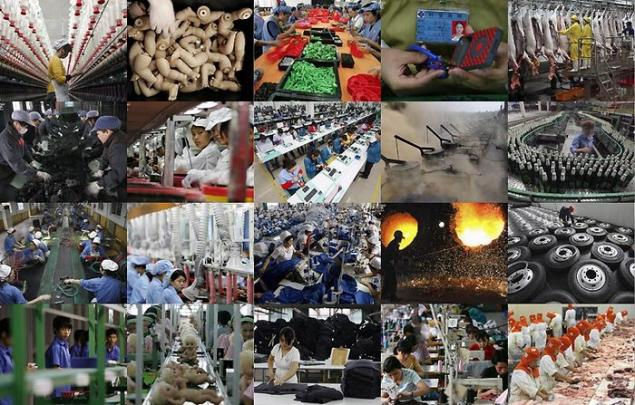
With the release of relatively cheap products, China has helped many people around the world to raise the standard of living. People around the world - in Brazil, Africa, Europe and America benefit from cheap Chinese goods. However, this situation has a downside: the buyers "vote your wallet" and often, buying cheaper products with the label «Made In China», put in the difficult position of local producers, which is becoming increasingly difficult to compete. In the end - the volume of local production is reduced, which means - fewer jobs, higher unemployment and, consequently, the consumer will buy more and more cheap Chinese goods. As buyers, we are pleased that today many luxury items became available to us, but we should be concerned about, as employees. China's success may mean that the economies of Africa and South America will have to find new ways to stay competitive. Yes, and Europe with the US can not feel safe. One dominant player will never be all happy.
1. Workers at Chinese factories: On the production line toy factory in Panyu, in southern China's Guangdong Province September 4, 2007. (REUTERS / Aly Song)
2. siesta working in a shoe factory in Ganzhou, Jiangxi Province, June 21, 2010 .. Ganzhou - recently emerged in the industrial region of Jiangxi Province, north of Guangdong. Because the yuan again crept upward, manufacturers export centers fear that it will lead to an increase in production costs will rise sharply as the wages of workers. (REUTERS / Bobby Yip)
3. Almost empty sewing workshop factory producing bags in Yiwu, Zhejiang Province, Feb. 15, 2011. According to the manual factory production is currently experiencing a severe shortage of workers. Rapidly developing production, located in the coastal areas in mainland China is now faced with the problem is particularly severe labor shortage, which is related to seasonal migrations during the whole month lasting celebration of the Lunar New Year. (REUTERS / Aly Song)
4. Production of fuses for production line of dynamite at a chemical plant in the city of Huaibei, Anhui Province, July 1, 2010. Production growth in China slowed in June 2010 in connection with the measures that the State has taken to "cool" the real estate market, as well as a reduction in bank lending. (REUTERS / Stringer)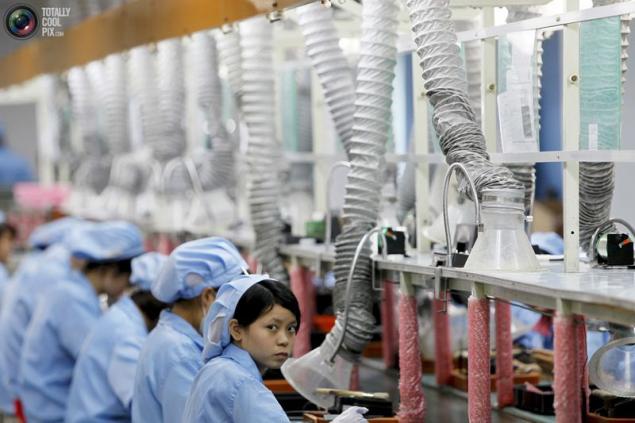
5. Work on the production line of the plant «Suzhou Etron Electronics Co. Ltd "in Suzhou, Jiangsu Province, June 8, 2010. Despite the fact that China is for the whole world a kind of universal "factory", the new generation of migrant workers from rural areas of China are much less likely to live in the manufacture than their parents. The reason was the low pay, overtime, and sometimes the military regime that reigns on Chinese enterprises. A whole series of suicides in the workplace, the company manufactures products of Apple, but also at other plants for the production of electronics, led to a scandalous case of migrant workers, which was followed by a massive condemnation of the Internet, as well as the predicament in which Western companies were dependent from Chinese manufactures. (REUTERS / Aly Song)
6. People at work in the shop on tailoring Huaybey, Anhui Province, July 8, 2010. Demographic dividend in China coming to an end. The era of unlimited supply of labor has already passed and will never return. (REUTERS / Stringer)
7. In this photo taken through a glass partition shows how workers inspect pig carcasses in a meat factory in Shenyang, Liaoning Province, July 15, 2010. Compared to the same period last year, the growth of China's economy in the second quarter fell to 10, 3%, while looking forward to even greater decline as a result of reduced government fiscal and monetary stimulus. (REUTERS / Sheng Li)
8. Work of the conveyor in a brewery «China Resources Snow Breweries Co., Ltd.» in Lanzhou, Gansu Province, Aug. 25, 2010. (REUTERS / Stringer)
9. The newly built factory building in Guangzhou, Jiangxi Province, June 22, 2010. (REUTERS / Bobby Yip / Files)
10. Workers on the production line plant for the production of lamps in Guangzhou, Jiangxi Province, June 22, 2010. (REUTERS / Bobby Yip / Files)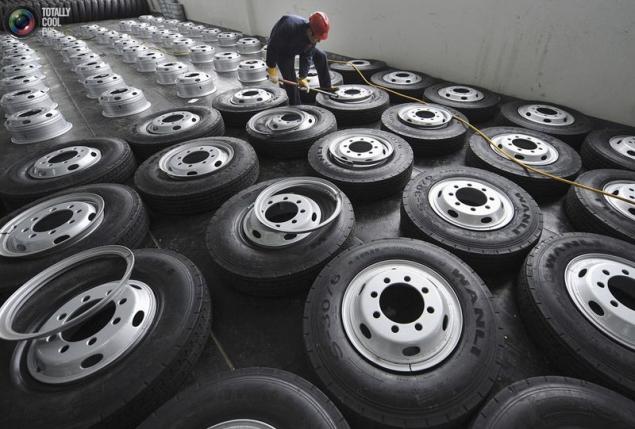
11. Work sets hoops factory «Zhengxing Wheel Group Co. Ltd. »in Hefey, Anhui Province, Jan. 20, 2011. The last, in 2010 successfully completed for China. Economic growth has exceeded expectations, while the inflation rate fell slightly. Economic indicators for December 2010, from the volume of production and ending amount of investments in the Chinese economy, showed a picture of sustainable development, proving that the second largest economy in the world is still far from overheating, despite the jump in growth. (REUTERS / Stringer)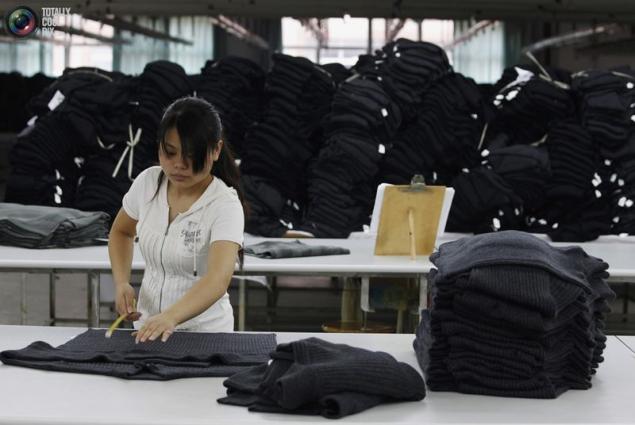
12. Work on the sewing factory in Guangzhou, Jiangxi Province, June 22, 2010. (REUTERS / Bobby Yip / Files)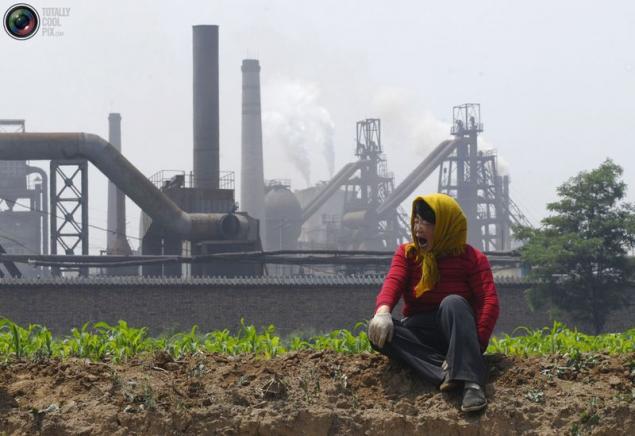
13. Agricultural worker during a break in the box located at the coke plant in Changzhi, Shanxi Province, June 8, 2009. One of the main problems faced by China, is a global climate change. On the way to his main goal - economic growth, China was under the influence of the international community, which demands from the Chinese government to reduce greenhouse gas emissions. (REUTERS / Stringer)
14. Working at a meat processing factory in Chengdu, Sichuan Province, June 16, 2009. Celestial is a world leader in the production and consumption of pork. Chinese Minister of Commerce said that the country accumulates reserves of frozen pork in order to maintain the level of prices for the meat product. (REUTERS / Stringer)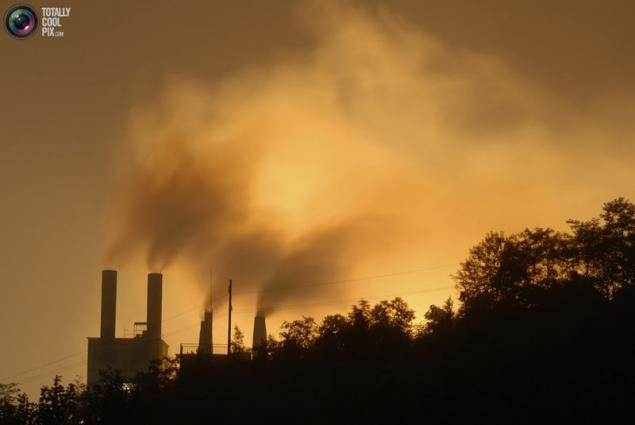
15. Smoke on the cement plant in Baokan, Hubei Province, Sept. 12, 2009. (REUTERS / Stringer)
16. The girl in the shop in the textile factory Huaybey city, Anhui province, February 4, 2010. According to state radio China, President Hu Jintao urged the country to make more efforts to transform the pattern of economic growth. (REUTERS / Stringer)
17. Stalevar in the hot shop at the factory Maanshanskoy stock metallurgical company in Hefei, Anhui Province, Jan. 21, 2010. (REUTERS / Stringer)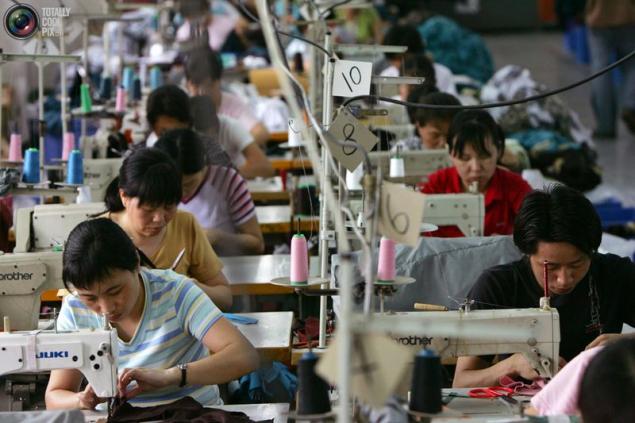
18. Chinese workers scribble t-shirts at a garment factory Bo So in Dongguan City, Guangdong Province, in the south. Last Thursday, US Secretary of Commerce Carlos Gutierrez arrived in Beijing three-day visit, the purpose of which is to settle the issue related to the sharp increase in textile exports from China. (REUTERS / Kin Cheung)
19. The flag of China flies in a cloud of smoke near the coke plant in Changzhi, Shanxi Province, May 29, 2008. The World Bank has authorized a loan of $ 441 million US dollars to improve ways to use energy and reduce emissions from power plants in China, said the representative of the World Bank in China. (REUTERS / Stringer)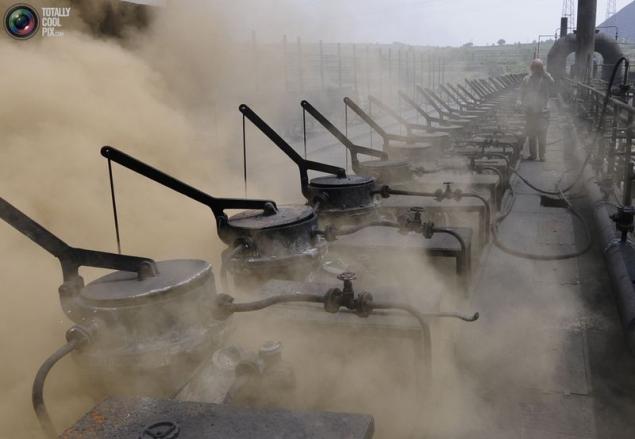
20. A worker walks past the kiln at the coke plant on the outskirts of Changzhi, Shanxi Province, June 5, 2008. China is facing a serious problem - water pollution and the environment in rural areas, said the representative of the Chinese Ministry of Environmental Protection. (REUTERS / Stringer)
21. Many of the unemployed came on a rainy day at a job fair in Hangzhou, Zhejiang Province, Feb. 28, 2009. At least 20 of the 130 million Chinese migrant workers lost their jobs when tens of thousands of export-oriented factories, which is dominated by manual labor, were closed due to the global financial crisis. As reported by Xinhua News Agency, throughout China offers many training centers of migrant workers.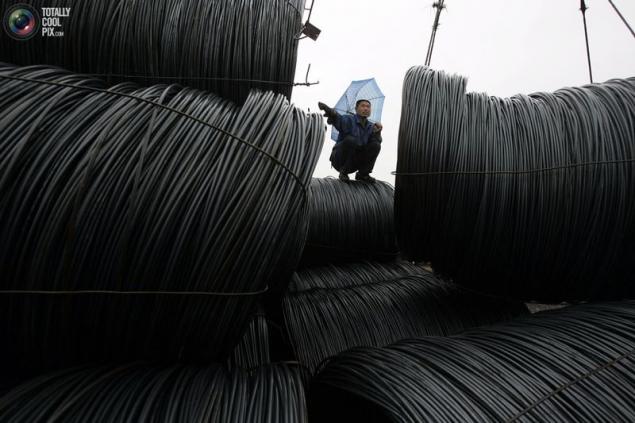
22. Work sits surrounded by huge steel coils on the market for the sale of steel products in Taiyuan, Shanxi Province, May 14, 2009. The Chinese Government is planning to take strict measures to producers of rolled steel, which increase production volumes, despite the reduction in demand, Xinhua news agency reported. (REUTERS / Stringer)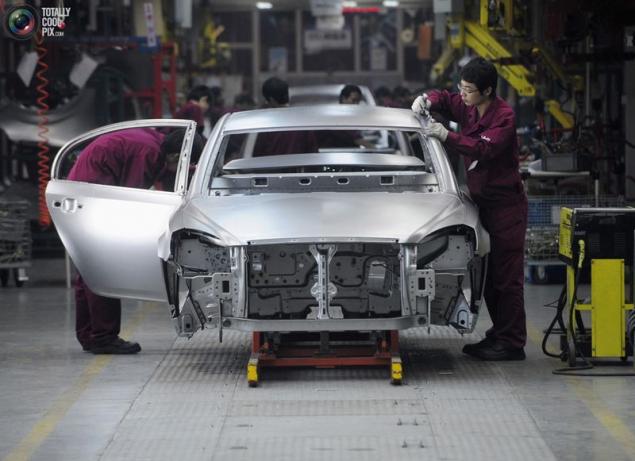
23. Work on the assembly line automobile plant «Anhui Jianghuai Automobile Co. Ltd. »in the city of Hefei, provintsiyaAnhuey October 21, 2009. (REUTERS / Stringer)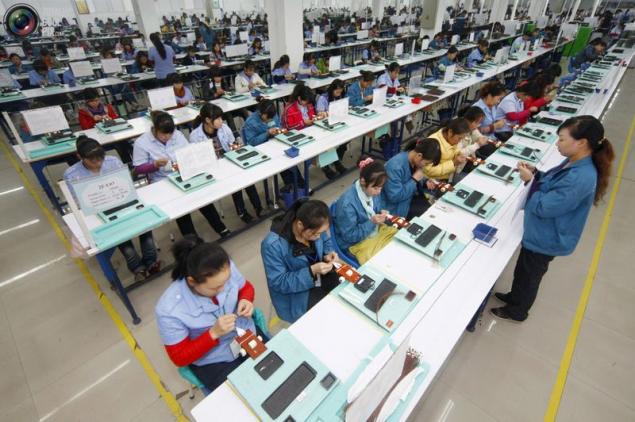
24. The Inspector (right) watches as workers produce electronic components in the production in Suining, Sichuan Province, November 1, 2010. (REUTERS / Stringer)
25. Workers assemble LED panel production in Suining, Sichuan Province, November 1, 2010. (REUTERS / Stringer)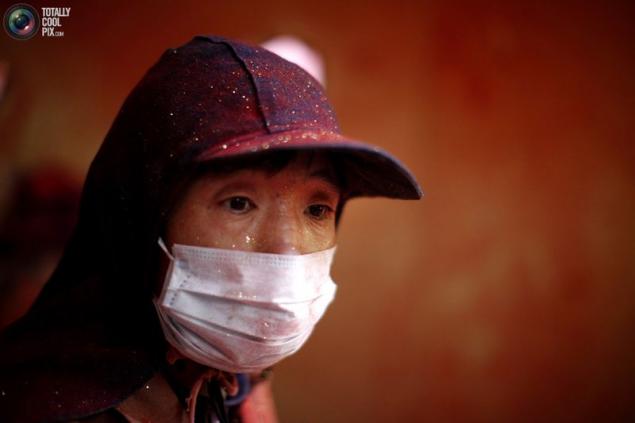
26. Work during a break in the production of Christmas decorations in Yiwu, Zhejiang Province, Jan. 11, 2011. (REUTERS / Carlos Barria)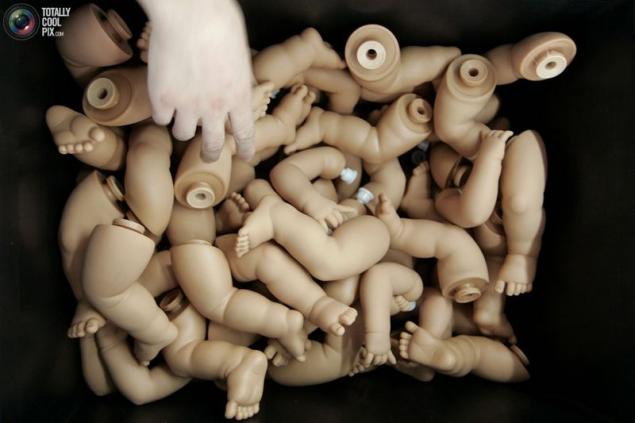
27. On the production line toy factory in Panyu, in southern China's Guangdong Province September 4, 2007. Chinese political leader Hu Jintao today has an unusually strong support within the country. He is committed to protecting the label "Made in China" and most likely will have to discuss trade and investment policy for the Asia-Pacific summit, which takes place this week. (REUTERS / Aly Song)
28. Factory workers in the assembly process at a toy factory in Panyu, in southern China's Guangdong Province September 4, 2007. (REUTERS / Aly Song)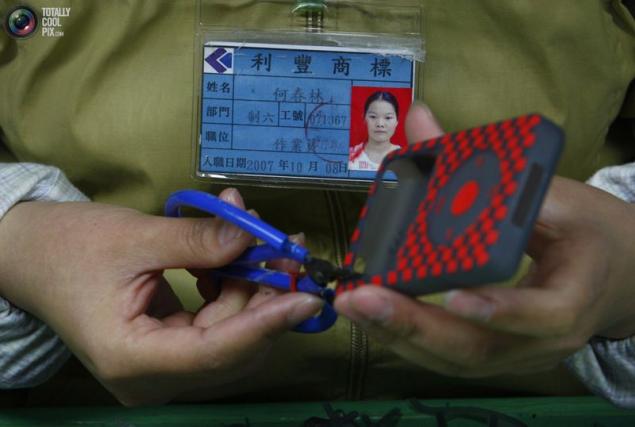
29. He Chunlin at work in a factory for the production of labels in Dongguan, located in Guangdong province, southern China January 25, 2008. (REUTERS / Jason Lee) 42,455,687
30. Construction of a chemical plant in Huay'ane, Jiangsu, March 2, 2008. (REUTERS / Patty Chen)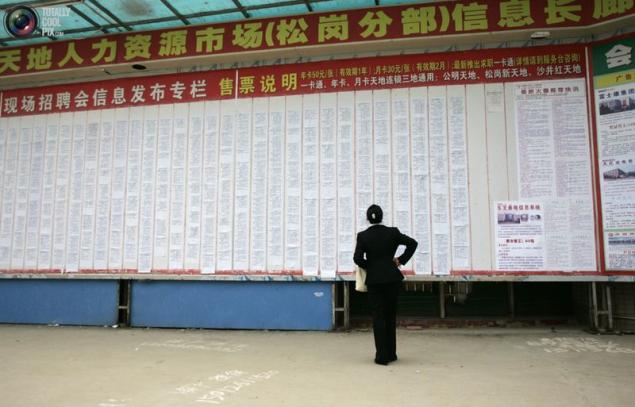
31. Unemployed reading classified ads in a half-empty Xintiandi employment center in the city of Songhai, province of Shenzhen, 22 January 2010. Many production capacity of Chinese export centers located in Pearl River Delta, are struggling to recruit and retain at workers who sometimes work illegally, as coming from the West orders for Chinese goods again gaining momentum, and the shortage of labor is widening. It is expected that the annual festivities on the occasion of the Lunar New Year will cause another wave of worker shortages, which may reduce the capacity and production capacity of the vital export sector. (REUTERS / James Pomfret)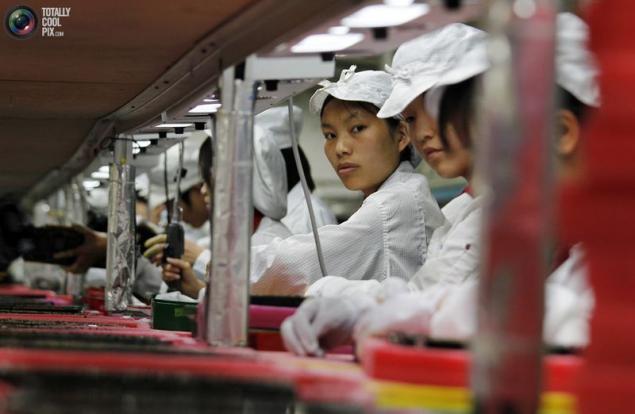
32. On-line factory «Foxconn» in the village of Longhua in Guangdong Province. May 26, 2010. A series of suicide nine factory workers producing electronics for Apple, drew attention to some ugly side of life "blue-collar" on it in China. (REUTERS / Bobby Yip)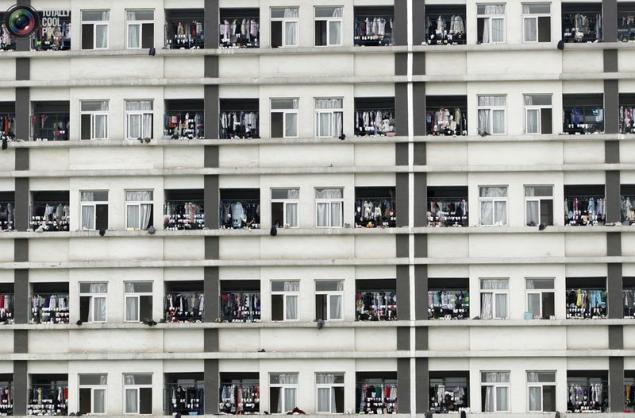
33. Drying clothes on the windows desktop hostel electronics factory in Suzhou, Jiangsu Province, June 8, 2010. (REUTERS / Aly Song)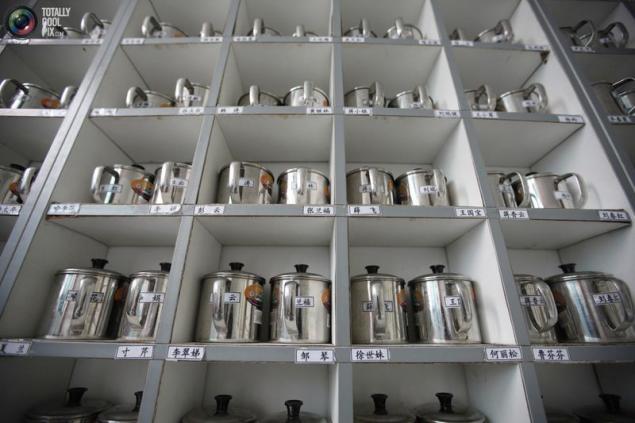
34. Metal mugs factory workers neatly arranged on a shelf in a recreation area in the factory «Suzhou Etron Electronics Co. Ltd »in Suzhou, Jiangsu Province. The picture was taken June 8, 2010. On the electronics factories for export to the US and European countries are more than 200 workers. (REUTERS / Aly Song)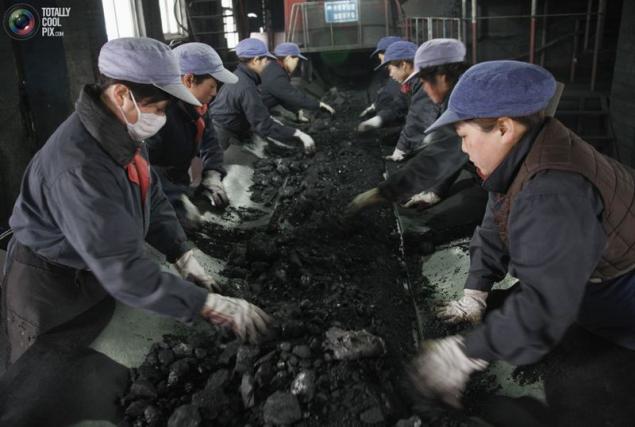
35. Working sorted coal in the washing shop at a coal mine in Huaibei, Anhui Province, March 8, 2010. In 2010, China set a goal - to increase coal production in the country up to 3, 15 billion tons, increasing it by 3, 3%, as reported in the annual development of the economy, compiled by the Ministry of Economic Planning and the Commission on National Development and Reform Commission, and released 5 of March. (REUTERS / Stringer)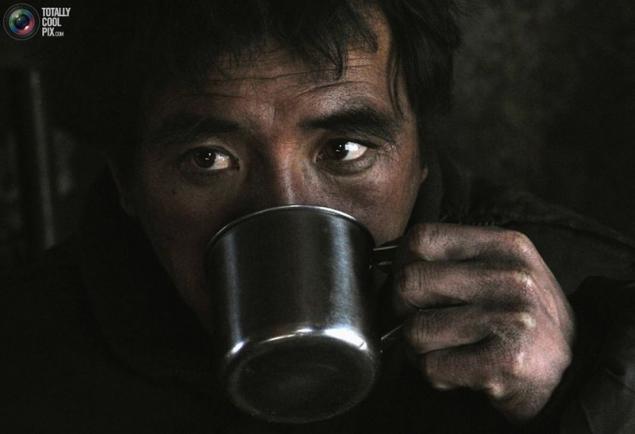
36. Work on the production of drinking water treatment and enrichment in Shenyang, Liaoning Province, March 19, 2009. (REUTERS / Sheng Li)
via Source

With the release of relatively cheap products, China has helped many people around the world to raise the standard of living. People around the world - in Brazil, Africa, Europe and America benefit from cheap Chinese goods. However, this situation has a downside: the buyers "vote your wallet" and often, buying cheaper products with the label «Made In China», put in the difficult position of local producers, which is becoming increasingly difficult to compete. In the end - the volume of local production is reduced, which means - fewer jobs, higher unemployment and, consequently, the consumer will buy more and more cheap Chinese goods. As buyers, we are pleased that today many luxury items became available to us, but we should be concerned about, as employees. China's success may mean that the economies of Africa and South America will have to find new ways to stay competitive. Yes, and Europe with the US can not feel safe. One dominant player will never be all happy.

1. Workers at Chinese factories: On the production line toy factory in Panyu, in southern China's Guangdong Province September 4, 2007. (REUTERS / Aly Song)

2. siesta working in a shoe factory in Ganzhou, Jiangxi Province, June 21, 2010 .. Ganzhou - recently emerged in the industrial region of Jiangxi Province, north of Guangdong. Because the yuan again crept upward, manufacturers export centers fear that it will lead to an increase in production costs will rise sharply as the wages of workers. (REUTERS / Bobby Yip)

3. Almost empty sewing workshop factory producing bags in Yiwu, Zhejiang Province, Feb. 15, 2011. According to the manual factory production is currently experiencing a severe shortage of workers. Rapidly developing production, located in the coastal areas in mainland China is now faced with the problem is particularly severe labor shortage, which is related to seasonal migrations during the whole month lasting celebration of the Lunar New Year. (REUTERS / Aly Song)

4. Production of fuses for production line of dynamite at a chemical plant in the city of Huaibei, Anhui Province, July 1, 2010. Production growth in China slowed in June 2010 in connection with the measures that the State has taken to "cool" the real estate market, as well as a reduction in bank lending. (REUTERS / Stringer)

5. Work on the production line of the plant «Suzhou Etron Electronics Co. Ltd "in Suzhou, Jiangsu Province, June 8, 2010. Despite the fact that China is for the whole world a kind of universal "factory", the new generation of migrant workers from rural areas of China are much less likely to live in the manufacture than their parents. The reason was the low pay, overtime, and sometimes the military regime that reigns on Chinese enterprises. A whole series of suicides in the workplace, the company manufactures products of Apple, but also at other plants for the production of electronics, led to a scandalous case of migrant workers, which was followed by a massive condemnation of the Internet, as well as the predicament in which Western companies were dependent from Chinese manufactures. (REUTERS / Aly Song)

6. People at work in the shop on tailoring Huaybey, Anhui Province, July 8, 2010. Demographic dividend in China coming to an end. The era of unlimited supply of labor has already passed and will never return. (REUTERS / Stringer)

7. In this photo taken through a glass partition shows how workers inspect pig carcasses in a meat factory in Shenyang, Liaoning Province, July 15, 2010. Compared to the same period last year, the growth of China's economy in the second quarter fell to 10, 3%, while looking forward to even greater decline as a result of reduced government fiscal and monetary stimulus. (REUTERS / Sheng Li)

8. Work of the conveyor in a brewery «China Resources Snow Breweries Co., Ltd.» in Lanzhou, Gansu Province, Aug. 25, 2010. (REUTERS / Stringer)

9. The newly built factory building in Guangzhou, Jiangxi Province, June 22, 2010. (REUTERS / Bobby Yip / Files)

10. Workers on the production line plant for the production of lamps in Guangzhou, Jiangxi Province, June 22, 2010. (REUTERS / Bobby Yip / Files)

11. Work sets hoops factory «Zhengxing Wheel Group Co. Ltd. »in Hefey, Anhui Province, Jan. 20, 2011. The last, in 2010 successfully completed for China. Economic growth has exceeded expectations, while the inflation rate fell slightly. Economic indicators for December 2010, from the volume of production and ending amount of investments in the Chinese economy, showed a picture of sustainable development, proving that the second largest economy in the world is still far from overheating, despite the jump in growth. (REUTERS / Stringer)

12. Work on the sewing factory in Guangzhou, Jiangxi Province, June 22, 2010. (REUTERS / Bobby Yip / Files)

13. Agricultural worker during a break in the box located at the coke plant in Changzhi, Shanxi Province, June 8, 2009. One of the main problems faced by China, is a global climate change. On the way to his main goal - economic growth, China was under the influence of the international community, which demands from the Chinese government to reduce greenhouse gas emissions. (REUTERS / Stringer)

14. Working at a meat processing factory in Chengdu, Sichuan Province, June 16, 2009. Celestial is a world leader in the production and consumption of pork. Chinese Minister of Commerce said that the country accumulates reserves of frozen pork in order to maintain the level of prices for the meat product. (REUTERS / Stringer)

15. Smoke on the cement plant in Baokan, Hubei Province, Sept. 12, 2009. (REUTERS / Stringer)

16. The girl in the shop in the textile factory Huaybey city, Anhui province, February 4, 2010. According to state radio China, President Hu Jintao urged the country to make more efforts to transform the pattern of economic growth. (REUTERS / Stringer)

17. Stalevar in the hot shop at the factory Maanshanskoy stock metallurgical company in Hefei, Anhui Province, Jan. 21, 2010. (REUTERS / Stringer)

18. Chinese workers scribble t-shirts at a garment factory Bo So in Dongguan City, Guangdong Province, in the south. Last Thursday, US Secretary of Commerce Carlos Gutierrez arrived in Beijing three-day visit, the purpose of which is to settle the issue related to the sharp increase in textile exports from China. (REUTERS / Kin Cheung)

19. The flag of China flies in a cloud of smoke near the coke plant in Changzhi, Shanxi Province, May 29, 2008. The World Bank has authorized a loan of $ 441 million US dollars to improve ways to use energy and reduce emissions from power plants in China, said the representative of the World Bank in China. (REUTERS / Stringer)

20. A worker walks past the kiln at the coke plant on the outskirts of Changzhi, Shanxi Province, June 5, 2008. China is facing a serious problem - water pollution and the environment in rural areas, said the representative of the Chinese Ministry of Environmental Protection. (REUTERS / Stringer)

21. Many of the unemployed came on a rainy day at a job fair in Hangzhou, Zhejiang Province, Feb. 28, 2009. At least 20 of the 130 million Chinese migrant workers lost their jobs when tens of thousands of export-oriented factories, which is dominated by manual labor, were closed due to the global financial crisis. As reported by Xinhua News Agency, throughout China offers many training centers of migrant workers.

22. Work sits surrounded by huge steel coils on the market for the sale of steel products in Taiyuan, Shanxi Province, May 14, 2009. The Chinese Government is planning to take strict measures to producers of rolled steel, which increase production volumes, despite the reduction in demand, Xinhua news agency reported. (REUTERS / Stringer)

23. Work on the assembly line automobile plant «Anhui Jianghuai Automobile Co. Ltd. »in the city of Hefei, provintsiyaAnhuey October 21, 2009. (REUTERS / Stringer)

24. The Inspector (right) watches as workers produce electronic components in the production in Suining, Sichuan Province, November 1, 2010. (REUTERS / Stringer)

25. Workers assemble LED panel production in Suining, Sichuan Province, November 1, 2010. (REUTERS / Stringer)

26. Work during a break in the production of Christmas decorations in Yiwu, Zhejiang Province, Jan. 11, 2011. (REUTERS / Carlos Barria)

27. On the production line toy factory in Panyu, in southern China's Guangdong Province September 4, 2007. Chinese political leader Hu Jintao today has an unusually strong support within the country. He is committed to protecting the label "Made in China" and most likely will have to discuss trade and investment policy for the Asia-Pacific summit, which takes place this week. (REUTERS / Aly Song)

28. Factory workers in the assembly process at a toy factory in Panyu, in southern China's Guangdong Province September 4, 2007. (REUTERS / Aly Song)

29. He Chunlin at work in a factory for the production of labels in Dongguan, located in Guangdong province, southern China January 25, 2008. (REUTERS / Jason Lee) 42,455,687
30. Construction of a chemical plant in Huay'ane, Jiangsu, March 2, 2008. (REUTERS / Patty Chen)

31. Unemployed reading classified ads in a half-empty Xintiandi employment center in the city of Songhai, province of Shenzhen, 22 January 2010. Many production capacity of Chinese export centers located in Pearl River Delta, are struggling to recruit and retain at workers who sometimes work illegally, as coming from the West orders for Chinese goods again gaining momentum, and the shortage of labor is widening. It is expected that the annual festivities on the occasion of the Lunar New Year will cause another wave of worker shortages, which may reduce the capacity and production capacity of the vital export sector. (REUTERS / James Pomfret)

32. On-line factory «Foxconn» in the village of Longhua in Guangdong Province. May 26, 2010. A series of suicide nine factory workers producing electronics for Apple, drew attention to some ugly side of life "blue-collar" on it in China. (REUTERS / Bobby Yip)

33. Drying clothes on the windows desktop hostel electronics factory in Suzhou, Jiangsu Province, June 8, 2010. (REUTERS / Aly Song)

34. Metal mugs factory workers neatly arranged on a shelf in a recreation area in the factory «Suzhou Etron Electronics Co. Ltd »in Suzhou, Jiangsu Province. The picture was taken June 8, 2010. On the electronics factories for export to the US and European countries are more than 200 workers. (REUTERS / Aly Song)

35. Working sorted coal in the washing shop at a coal mine in Huaibei, Anhui Province, March 8, 2010. In 2010, China set a goal - to increase coal production in the country up to 3, 15 billion tons, increasing it by 3, 3%, as reported in the annual development of the economy, compiled by the Ministry of Economic Planning and the Commission on National Development and Reform Commission, and released 5 of March. (REUTERS / Stringer)

36. Work on the production of drinking water treatment and enrichment in Shenyang, Liaoning Province, March 19, 2009. (REUTERS / Sheng Li)
via Source
Tags
See also
Chinese factories for the production of headphones, mice and webcams
Manufacture of fireworks (35 photos)
Renewable sources is not enough. Clean Coal - Energy of the near future
Report from the best Latvian sprat production plant
If tomorrow the Apocalypse
Secluded place
Stunning views of Shanghai
Abandoned factory for the production of tequila.

















